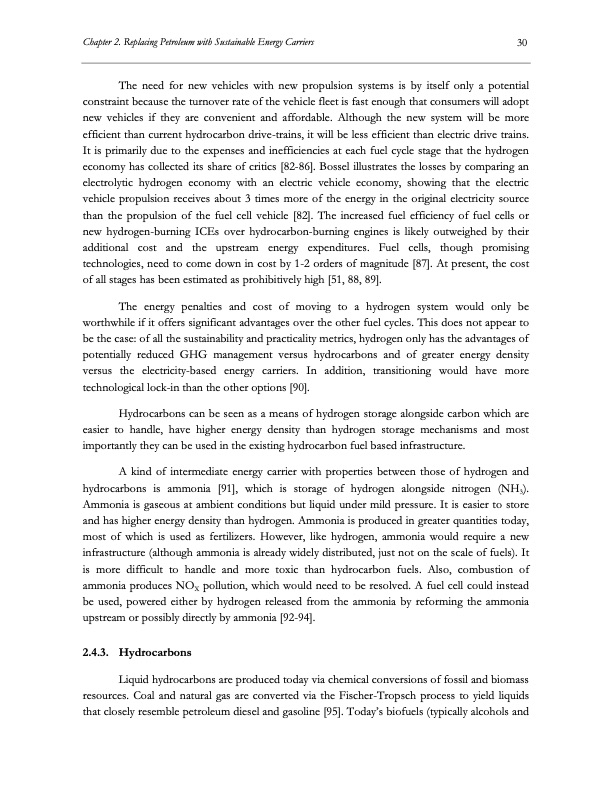
PDF Publication Title:
Text from PDF Page: 051
Chapter 2. Replacing Petroleum with Sustainable Energy Carriers 30 The need for new vehicles with new propulsion systems is by itself only a potential constraint because the turnover rate of the vehicle fleet is fast enough that consumers will adopt new vehicles if they are convenient and affordable. Although the new system will be more efficient than current hydrocarbon drive-trains, it will be less efficient than electric drive trains. It is primarily due to the expenses and inefficiencies at each fuel cycle stage that the hydrogen economy has collected its share of critics [82-86]. Bossel illustrates the losses by comparing an electrolytic hydrogen economy with an electric vehicle economy, showing that the electric vehicle propulsion receives about 3 times more of the energy in the original electricity source than the propulsion of the fuel cell vehicle [82]. The increased fuel efficiency of fuel cells or new hydrogen-burning ICEs over hydrocarbon-burning engines is likely outweighed by their additional cost and the upstream energy expenditures. Fuel cells, though promising technologies, need to come down in cost by 1-2 orders of magnitude [87]. At present, the cost of all stages has been estimated as prohibitively high [51, 88, 89]. The energy penalties and cost of moving to a hydrogen system would only be worthwhile if it offers significant advantages over the other fuel cycles. This does not appear to be the case: of all the sustainability and practicality metrics, hydrogen only has the advantages of potentially reduced GHG management versus hydrocarbons and of greater energy density versus the electricity-based energy carriers. In addition, transitioning would have more technological lock-in than the other options [90]. Hydrocarbons can be seen as a means of hydrogen storage alongside carbon which are easier to handle, have higher energy density than hydrogen storage mechanisms and most importantly they can be used in the existing hydrocarbon fuel based infrastructure. A kind of intermediate energy carrier with properties between those of hydrogen and hydrocarbons is ammonia [91], which is storage of hydrogen alongside nitrogen (NH3). Ammonia is gaseous at ambient conditions but liquid under mild pressure. It is easier to store and has higher energy density than hydrogen. Ammonia is produced in greater quantities today, most of which is used as fertilizers. However, like hydrogen, ammonia would require a new infrastructure (although ammonia is already widely distributed, just not on the scale of fuels). It is more difficult to handle and more toxic than hydrocarbon fuels. Also, combustion of ammonia produces NOX pollution, which would need to be resolved. A fuel cell could instead be used, powered either by hydrogen released from the ammonia by reforming the ammonia upstream or possibly directly by ammonia [92-94]. 2.4.3. Hydrocarbons Liquid hydrocarbons are produced today via chemical conversions of fossil and biomass resources. Coal and natural gas are converted via the Fischer-Tropsch process to yield liquids that closely resemble petroleum diesel and gasoline [95]. Today’s biofuels (typically alcohols andPDF Image | Electrolysis of CO2 and H2O

PDF Search Title:
Electrolysis of CO2 and H2OOriginal File Name Searched:
co2-hso-fuels.pdfDIY PDF Search: Google It | Yahoo | Bing
NFT (Non Fungible Token): Buy our tech, design, development or system NFT and become part of our tech NFT network... More Info
IT XR Project Redstone NFT Available for Sale: NFT for high tech turbine design with one part 3D printed counter-rotating energy turbine. Be part of the future with this NFT. Can be bought and sold but only one design NFT exists. Royalties go to the developer (Infinity) to keep enhancing design and applications... More Info
Infinity Turbine IT XR Project Redstone Design: NFT for sale... NFT for high tech turbine design with one part 3D printed counter-rotating energy turbine. Includes all rights to this turbine design, including license for Fluid Handling Block I and II for the turbine assembly and housing. The NFT includes the blueprints (cad/cam), revenue streams, and all future development of the IT XR Project Redstone... More Info
Infinity Turbine ROT Radial Outflow Turbine 24 Design and Worldwide Rights: NFT for sale... NFT for the ROT 24 energy turbine. Be part of the future with this NFT. This design can be bought and sold but only one design NFT exists. You may manufacture the unit, or get the revenues from its sale from Infinity Turbine. Royalties go to the developer (Infinity) to keep enhancing design and applications... More Info
Infinity Supercritical CO2 10 Liter Extractor Design and Worldwide Rights: The Infinity Supercritical 10L CO2 extractor is for botanical oil extraction, which is rich in terpenes and can produce shelf ready full spectrum oil. With over 5 years of development, this industry leader mature extractor machine has been sold since 2015 and is part of many profitable businesses. The process can also be used for electrowinning, e-waste recycling, and lithium battery recycling, gold mining electronic wastes, precious metals. CO2 can also be used in a reverse fuel cell with nafion to make a gas-to-liquids fuel, such as methanol, ethanol and butanol or ethylene. Supercritical CO2 has also been used for treating nafion to make it more effective catalyst. This NFT is for the purchase of worldwide rights which includes the design. More Info
NFT (Non Fungible Token): Buy our tech, design, development or system NFT and become part of our tech NFT network... More Info
Infinity Turbine Products: Special for this month, any plans are $10,000 for complete Cad/Cam blueprints. License is for one build. Try before you buy a production license. May pay by Bitcoin or other Crypto. Products Page... More Info
| CONTACT TEL: 608-238-6001 Email: greg@infinityturbine.com | RSS | AMP |